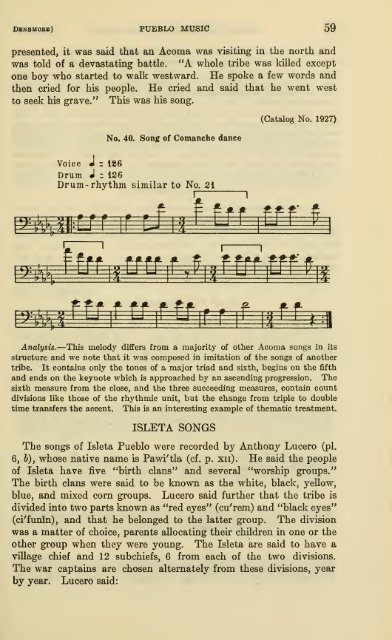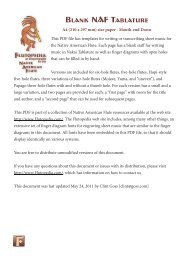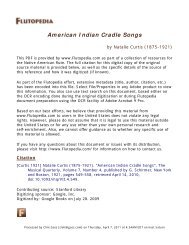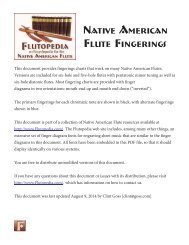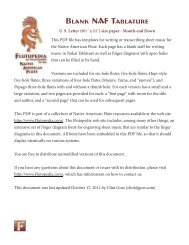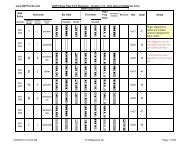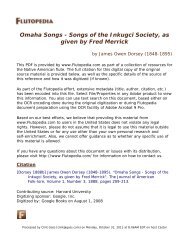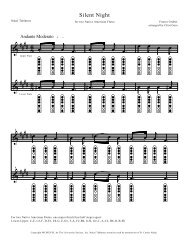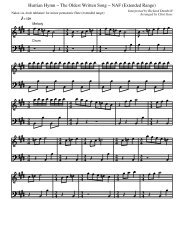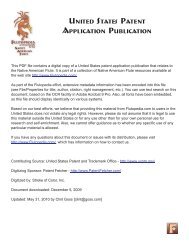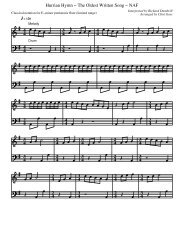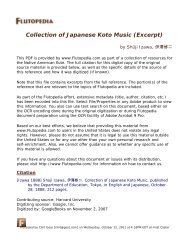Music of Acoma, Isleta, Cochiti, and Zuñi Pueblos - Flutopedia.com
Music of Acoma, Isleta, Cochiti, and Zuñi Pueblos - Flutopedia.com
Music of Acoma, Isleta, Cochiti, and Zuñi Pueblos - Flutopedia.com
Create successful ePaper yourself
Turn your PDF publications into a flip-book with our unique Google optimized e-Paper software.
Dbnsmobb] PUEBLO MUSIC 59<br />
was said that an <strong>A<strong>com</strong>a</strong> was visiting in the north <strong>and</strong><br />
presented, it<br />
was told <strong>of</strong> a devastating battle. "A whole tribe was killed except<br />
one boy who started to walk westward. He spoke a few words <strong>and</strong><br />
then cried for his people. He cried <strong>and</strong> said that he went west<br />
to seek his grave." This was his song.<br />
(Catalog No. 1927)<br />
No. 40.<br />
Song <strong>of</strong> Comanche dance<br />
Voice J z 186<br />
Drum J z 126<br />
Drum- rhythm similar to No. 21<br />
^^<br />
•<br />
^ £ffi^tftf |f<br />
j|<br />
•<br />
i £ff i<br />
tff<br />
f<br />
^<br />
jjffrf |tfff|^i<br />
ii,i, fffifffiffrii<br />
I<br />
|f iiffi i<br />
Analysis.—This melody differs from a majority <strong>of</strong> other <strong>A<strong>com</strong>a</strong> songs in its<br />
structure <strong>and</strong> we note that it was <strong>com</strong>posed in imitation <strong>of</strong> the songs <strong>of</strong> another<br />
tribe. It contains only the tones <strong>of</strong> a major triad <strong>and</strong> sixth, begins on the fifth<br />
<strong>and</strong> ends on the keynote which is approached by an ascending progression. The<br />
sixth measure from the close, <strong>and</strong> the three succeeding measures, contain count<br />
divisions like those <strong>of</strong> the rhythmic unit, but the change from triple to double<br />
time transfers the accent. This is an interesting example <strong>of</strong> thematic treatment.<br />
ISLETA SONGS<br />
The songs <strong>of</strong> <strong>Isleta</strong> Pueblo were recorded by Anthony Lucero (pi.<br />
6, 6), whose native name is Pawi'tla (cf. p. xii). He said the people<br />
<strong>of</strong> <strong>Isleta</strong> have five "birth clans" <strong>and</strong> several "worship groups."<br />
The birth clans were said to be known as the white, black, yellow,<br />
blue, <strong>and</strong> mixed corn groups, Lucero said further that the tribe is<br />
divided into two parts known as "red eyes" (cu'rem) <strong>and</strong> "black eyes"<br />
(ci'funin), <strong>and</strong> that he belonged to the latter group. The division<br />
was a matter <strong>of</strong> choice, parents allocating their children in one or the<br />
other group when they were young. The <strong>Isleta</strong> are said to have a<br />
village chief <strong>and</strong> 12 subchiefs, 6 from each <strong>of</strong> the two divisions.<br />
The war captains are chosen alternately from these divisions, year<br />
by year. Lucero said:


